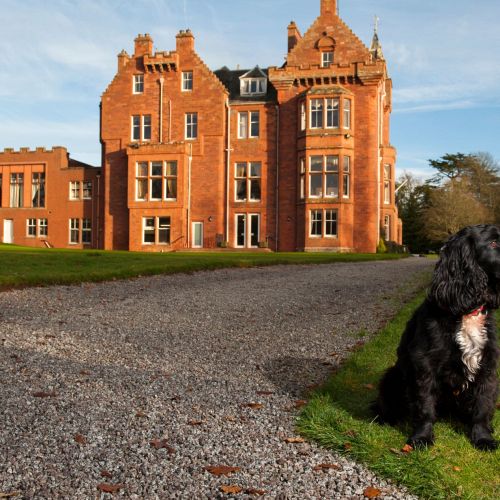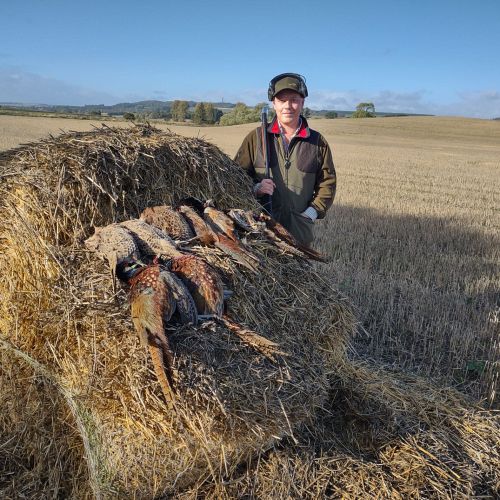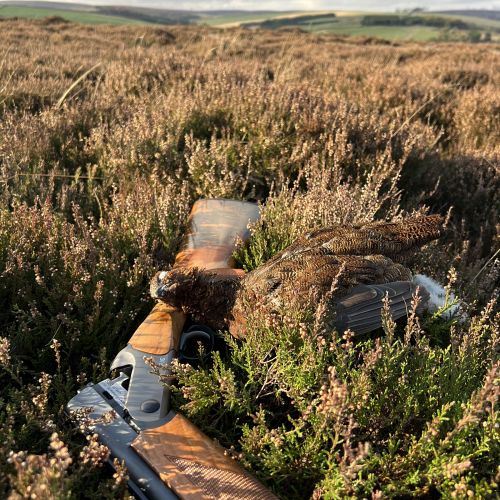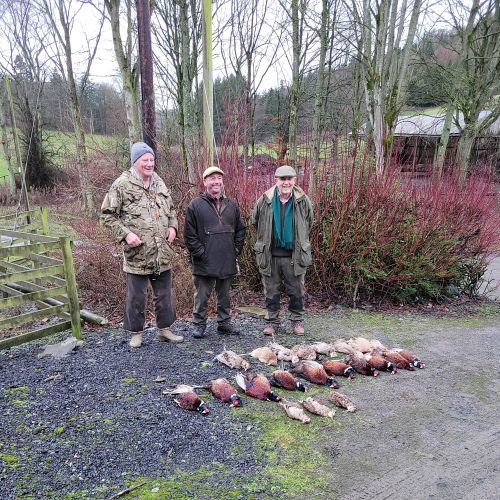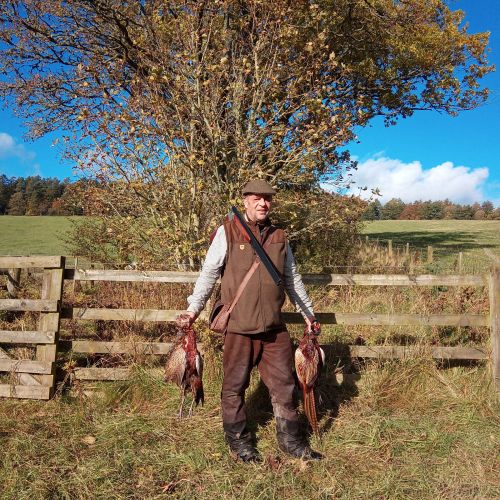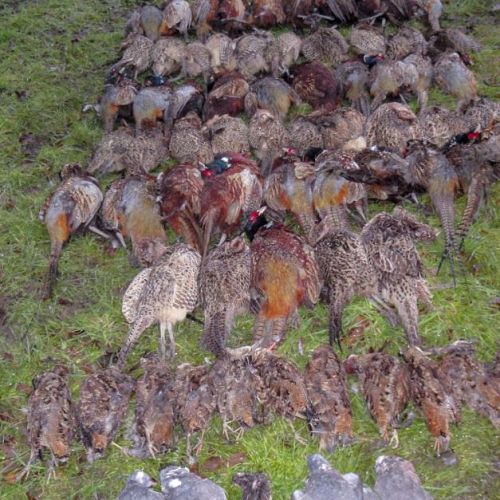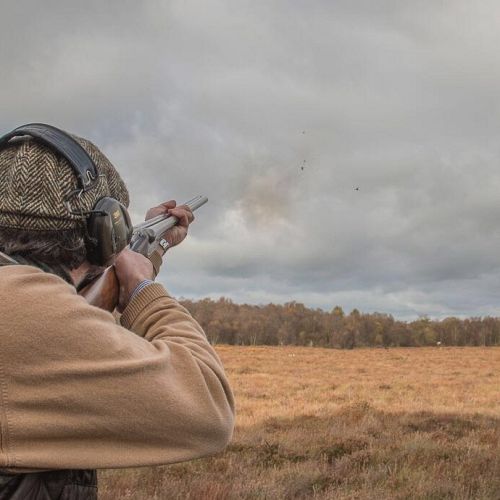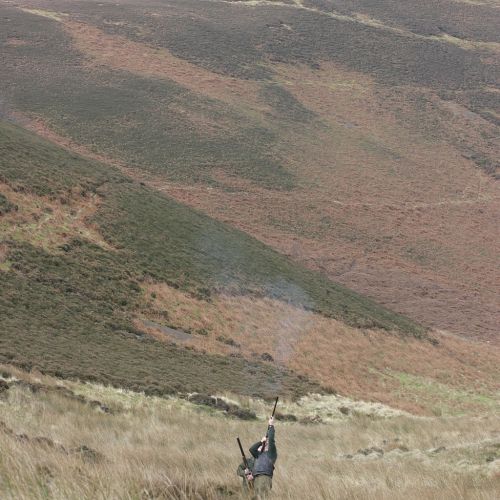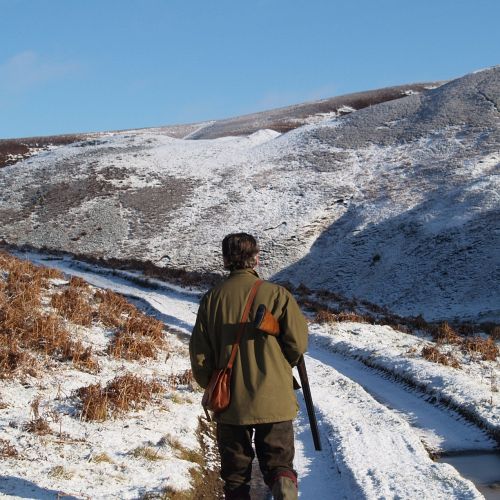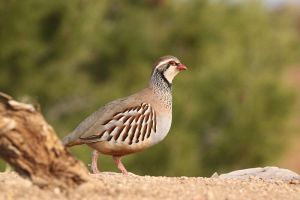Walked up / Rough shooting in Melrose
Those who have experienced a classic rough shooting in Scotland know that the hunt itself is only part of the experience. The true joy lies in the companionship, the work of the dogs, and the hunt through the beautiful rolling landscape. Combined with the hospitality, the traditional estates, and the cozy atmosphere at the lodge, a rough shooting becomes an experience you’ll never forget.
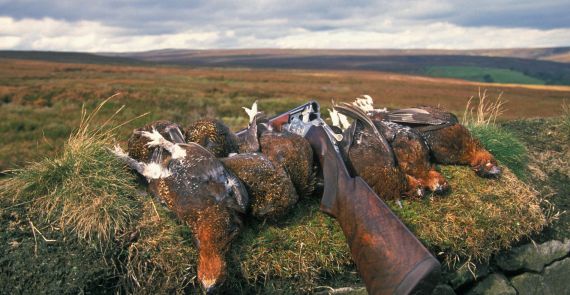
Highlights
- Very beautiful countryside
- The ultimate Scottish hunting experience
- Our partner has access to more than 40,000 hectares hunting ground
- Overwhelming choice or very varied hunting
5 days from €3,095
Scotland – Tradition, hospitality, and classic shooting
Scotland has a proud hunting heritage and offers a wide variety of game and shooting opportunities. One of the most traditional and social forms of hunting is rough shooting or walk-up shooting, where camaraderie and enjoyment are at the heart of the experience. The hunts take place in beautiful and varied landscapes, often with a focus on several different species rather than on large numbers of game.
We hold exclusive rights to a family-run hunting hotel of international standard – a unique offer for hunters seeking the ultimate Scottish hunting experience. Accommodation is tailor-made for hunters and their companions, and first-class hunting grounds are located within a short distance of the hotel.
The family’s goal, when acquiring the hotel in April 2007, was to combine the perfect hunting stay with outstanding hunting on a magnificent estate. In other words: a complete hunting experience where both lodging and shooting grounds are designed specifically for hunters, and where personal service and expertise are second to none. The family who runs the hotel has access to more than 40,000 hectares of professionally managed hunting areas within a 35-minute drive from the hotel.
The hunt
A rough shooting day typically takes place with hunters and dog handlers forming a line and walking through a variety of terrains with well-trained Labradors and Spaniels. The hunt covers both upland and lowland areas, including meadows, lochs, and rivers.
In the higher ground, the focus is mainly on hare, partridge, and grouse, while in the lower areas the quarry includes hare, rabbit, snipe, woodcock, partridge, pheasant, and duck. One can expect an average bag of 5–10 head of game per hunter per day – sometimes even more.
A typical rough shooting day:
- “Full Scottish Breakfast” at the hotel
- Departure from the hotel around 9:00 a.m.
- Morning shoot
- Lunch in the field
- Afternoon shoot (optional evening duck flighting in certain areas)
- Dinner at the hotel in the evening
Season: October to January
Recommended clothing: Waterproof and windproof jacket and trousers, sturdy boots, hat or cap.
Shotgun: 12, 16, or 20 gauge
Ammunition: Cartridges can be purchased locally.
Accommodation
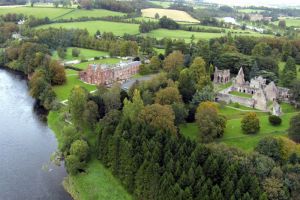
Dryburgh Hotel
The hotel, which is only an hours drive from Edinburgh airport, is beautifully located on the banks of the River Tweed in the heart of the Scottish Borders. Most of the rooms and public areas offer views over the river. The hotel is a luxuriously furnished 4-star hotel featuring an exceptional restaurant. The menu, as you might expect, features many game dishes with seasonal, locally produced...
Read moreHunting Area
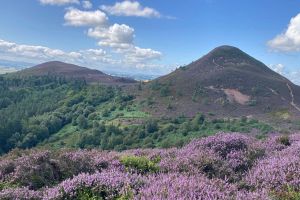
Melrose
Familiens formål, med at erhverve hotellet i april 2007, var at kombinere det perfekte jagtophold med den perfekte jagt på et fantastisk revir. Altså en samlet jagtoplevelse, hvor både indkvarteringen og jagtområdet er skræddersyet til jægeren, og hvor partneren har stor erfaring og yder stor service. Familien, der driver hotellet har adgang til mere end...
Read moreGame
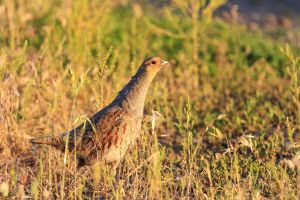
Grey Partridge
Scientific Name: Francolinus pondicerianus Sub-species: n/a Habitat: Grassy areas is scrubland and open country Description: Medium sized francolin 26-34cm long. Barred grey/brown plumage with a thin black border to its pale throat. Hunting method: Wing shooting, walking-up Hunting available in: Europe
Read more
Hare, European
Scientific Name: Lepus europaeus Subspecies: Up to 30 subspecies of hare have been described, but the number is disputed and the differences of little interest to hunters. Distribution: Native to much of Europe and part of west/central Asia. Introduced to many countries including England, Scotland, Sweden, Argentina, Australia and New Zealand. Habitat: Found in many types of habitats,...
Read more
Pheasant
Scientific Name: Phasianus coachicus Subspecies: There are thought to be about 30 subspecies, divided into 5 groups: the Caucasus pheasants, White-winged pheasants, Mongolian ring-necked pheasants, Tarim pheasants and the Chinese ring-necked pheasants. Distribution: Native to Asia but widely introduced elsewhere. Common throughout much of Europe. Habitat: Ground dwelling bird of woods,...
Read more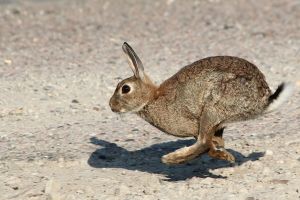
Rabbit, European Wild
Scientific Name: Oryctolagus cuniculus Subspecies: 3 subspecies are recognised: European rabbit (Oryctolagus cuniculus cuniculus), North African rabbit (O. cuniculus algirus), Iberian rabbit (Oryctolagus cuniculus) Distribution: Native to southwest Europe (Spain, Portugal and western France) and north west Africa (Morocco and Algeria). Widely introduced elsewhere. Habitat: Vegetated areas,...
Read more
Snipe, Common
Scientific Name: Gallinago gallinago Subspecies: None Distribution: Breeds through most of temperate and northern Europe and into Asia. Habitat: Freshwater marshes, moors, fields Description: Small wading bird, well camouflaged and with a long bill. Mottled brown and black above, with bold, buff coloured stripes on the back forming a V. 25 - 27cm in size. Hunting method: Rough...
Read more
Woodcock, Eurasian
Scientific Name: Scolopax rusticola Subspecies: None Distribution: Breeds through most of temperate and northern Europe and into Asia. Habitat: Forests and woods. Description: Bulky wading bird, well camouflaged by brown and buff barring, creating a “dead leaf” effect. Long down pointing bill. In flight its rounded wings are diagnostic. Size: 32 - 36cm Hunting method: Rough...
Read moreGame that may be purchased additionally
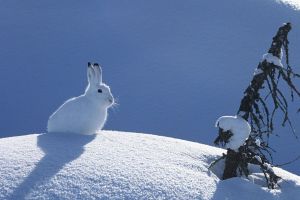
Arctic hare
Scientific name: Lepus arcticus groenlandicus Distribution: Arctic hares in Greenland are found in the Arctic regions, including the tundra and open mountain plateaus. Habitat: Arctic hares in Greenland primarily inhabit tundra areas and open mountain regions. Description: Arctic hares are medium-sized mammals specialized for life in cold climates. They have a seasonal coat that changes from...
Read more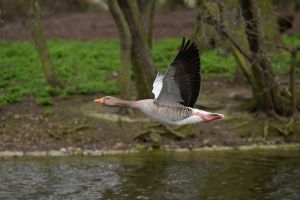
Goose
Scientific Name: Anser anser Subspecies: Two subspecies are recognised: the western greylag goose (A. a. anser) which breeds in Iceland and northern and central Europe and the eastern greylag goose (A. a. rubrirostris) which breeds in Romania, Turkey, Russia and eastwards to northeast China. Distribution: Iceland and east through northern Europe, Russia and Asia to northeastern China....
Read more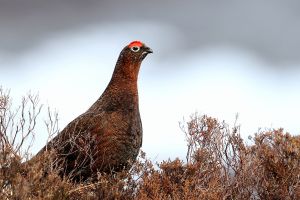
Grouse
Scientific Name: Tetrastes bonasia Subspecies: N/A Distribution: From central Europe, across northern Eurasia to northern Japan. Habitat: Conifer and mixed forest Description: Relatively small member of the grouse family. Adult males grey above, with mottled buff, orange, black and browns in wings. Black chin, bordered with white. Boldly spotted white underparts. Female lacks the black bid....
Read morePrices

The price includes
- 4 days stay at Dryburgh Abbey Hotel (shared double room)
- 3 days mixed small game shooting (5-10 pieces of game per hunter/day)
- Full breakfast and dinner included (lunch during the hunt)
- All transport during the hunt
The price does not include
- Flight to Edinburgh
- Rental car / Transfer to and from airport
- Supplement for stay in October, € 75,- per person (High season)
- Single room supplement, € 350,- per person
- Scottish weapon permit € 150,- (if own weapon)
- Shotgun rental, € 66 per day/hunter (recommended)
- Cartridges, approx. £12-15 per box with 25 (to be paid directly)
- Tips for host and hunting guides
- Fee for bringing own shotguns on airplane
- EU-public liability insurance € 10,00,-
- Travel- and cancellation insurance
- Everything not listed under "The price includes"
Diana Hunting Tours has partnered with the travel insurance company European (ERV) and is pleased to offer you an ideal travel insurance solution for your hunting trip, as well as cancellation insurance in case you need to cancel the trip due to illness.
Please note that this insurance offer is available only to residents of Denmark, Norway, Sweden, Iceland, Greenland, the Faroe Islands, Germany, Finland, and the Netherlands.
If you would like to purchase travel or cancellation insurance through Diana Hunting Tours, please contact your travel consultant or our support team at +45 62 20 25 40, or send an email to info@diana.dk.
Exchange Rate
The price show for this tour is for guidance only as fluctuations in the exchange rate may need to be taken into account. The actual price of the tour will be agreed later.
















